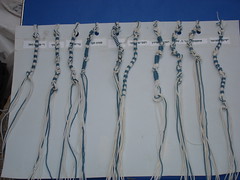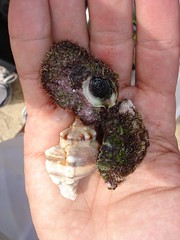The Search for the Mysterious Chilazon: Has it Finally Been Discovered?
Here is a link to the camp video of the tour where we search for the chilozon and learn how to make Ticheilet for Tzitzit. Sdei Chemed Boys – Tekhelet Expedition
I decided to post this article now as it’s in this weeks Parsha, Parshat Terumah where we learn about the tekhelet for the first time.
The Search for the Mysterious Chilazon; Has it Finally Been Discovered?
By Rabbi Eli Teitelbaum
| Styles of tying with tekhelet (Photo credit: RahelSharon) |
The mitzvah of Tzitzis is equal to all the other mitzvos in the Torah says the gemara, yet for more than a thousand years the blue thread that the Torah tells us to put onto the corners of the garment has been missing. That’s because the thread must be colored with a blue dye coming from a sea creature called a chilazon whose identity we don’t seem to know. This sea creature was obviously very well known in ancient times but was probably forgotten when the Jews went into exile to Bavel. This dye was very important in ancient times since it was used by kings and princes to dye their robes. It seemed to have been a very expensive dye literally worth its weight in gold. The Torah in Parsas Zos Ha’bracha) tells us that the tribe of Yisachar and Z’vulon were given the ocean which contained “treasures buried in the sand,” which the gemara in Mesechta Megillah (6a) says refers to the chilazon and other treasures found in the ocean. The gemarah (Menachos 44a) also says that they would “come up” only once in seventy years.
While it was well known that the Mediterranean coast was the center of the dyeing industry in ancient times, the source of this dye has remained a great mystery. It seems to be that with the Arab conquest of Eretz Yisroel in 639 CE, the secret of tekhelet was lost and forgotten.
Luckily, the gemara tells us that the blue thread is actually a separate mitzvah and therefore we still get the mitzvah of tzitzis even though we are missing the blue thread. However, we unfortunately do miss out on the very great mitzvah of having the blue thread.
Rabbi Meir says (Sifri, Shelach 15,39) that “whoever observes the mitzvah of tsitsis, is considered as if he greeted the Shchina, for the techeles resembles the sea, and the sea resembles the sky, and the sky resembles Hashem’s Holy Throne.” (See Minochos 43b)
We first find techeles used in the making of the Mishkan. Rashi tells us in Parshas Terumah that it came from the blood of a chilazon and its color is (yarok) green. This seems rather strange, since it is generally accepted that techeles is blue and not green?
From the gemorah’s description in Mesechta Shabbos (85a) it seems that the chilazon has a hard shell and one is not permitted to break it open on Shabbos. This would seem to indicate that it’s some kind of snail and not a fish. The medrash (Psiktah d’Rav Kahana 11:21) also describes it as a creature who’s nartek (meaning shell or housing) grows along with it, which is of course a snail. The gemorah (Bava Metzia 61b) also tells us that one had to be very wary due to those who tried to cheat you and use an artificial coloring called Kalai ilon, which looked identical in color to techeles. In fact the color was such a perfect match that there was no way anyone could tell them apart. And since as we all know, when there is some money to be made there are always plenty of cheats and frauds, people had to be very careful to make sure that the blue dye came from the chilazon and not from kala ilon. Kala ilan has been identified as indigo which is a blue dye of vegetable origin. (See the Aruch and the Radvaz Responsa 2:685). The gemorra also tells us that this blue dye would hold fast and not fade away by washing etc. And so while the search for the mysterious chilazon probably went on for many years, its identity remained unknown. It would have to fit all the above requirements in order for us to make a positive identification.
| Murex trunculus (Photo credit: RahelSharon) |
It was first in 1887 that the great gaon Rabbi Gershon Henoch Leiner, also known as the Radziner Rebbe began an intensive search for the lost chilazon. He in fact went to visit an aquarium in Italy to study the many species of fish in order to see if any of them fit the description. He finally came up with a fish called a cuttlefish (Sepia officinalis, a type of squid). An Italian chemist showed him that by adding some iron filings to its blood and heating it, it would make a blue color. His conclusion however was met with great skepticism as many refuted his findings. In fact, by using his method, virtually all organic substances would also make a blue dye. Another problem was that cuttlefish are quite common, cannot exist in sand, and the ink is certainly not expensive to produce. Furthermore, a cuttlefish does not have an external shell but only an internal shell which does not have to be broken in order to get to the ink. Obviously the Rebbe had been misled by an unscrupulous chemist. The pros and cons can be found in the many seforim on this subject.
| English: Some wool dipped in techelet solution, turning blue in the sunlight outside P’til Techelet in Israel. (Photo credit: Wikipedia) |
It is interesting to note that in 1858 the French zoologist Henri de Lacaze-Duthiers discovered three mollusks in the Mediterranean which produced purple-blue dyes and which he believed must have been the source of the ancient royal blue color. Interestingly enough, thousands of the Murex trunculas shells as well as the remains of a dye factory have been found near Sidon. The shells of these snails all have been cracked open on the very spot from which one takes out the (hypobranchial) gland from which one makes the dye. This is a sure sign that they were once used in the dye process.
The strongest evidence of all, is that the chemical structure of this dye is identical to that of k’la ilan or indigo. This is why the gemarah says that one can easily be fooled by it. The one mystery that still puzzles us is the gemarah that says that it comes up once in seventy years. This may simply mean that they are washed ashore once every seventy years. We’ll just have to wait and see if this phenomenon holds true or perhaps there is some other solution
From Camp Sdei Chemed, here.



